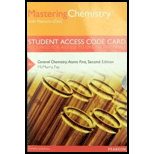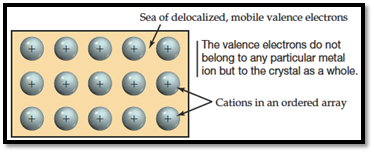
Masteringchemistry with Pearson Etext -- Standalone Access Code Card -- For General Chemistry
2nd Edition
ISBN: 9780321813282
Author: John C. McMurry
Publisher: PEARSON
expand_more
expand_more
format_list_bulleted
Concept explainers
Question
Chapter 21, Problem 21.57SP
Interpretation Introduction
Interpretation:
The difference in melting point between magnesium and sodium has to be explained using electron-sea model.
Concept introduction:
Electron-sea model:
- Metals with single valence electron cannot not be localized because of less valence electrons to form electron pair.
- As a result valence electrons does not form electron pair bond between any atoms. But the valence electrons are delocalized and contributes for whole crystal.
- In electron sea model, metal cations are in a sea of electrons which moves freely in entire crystal.

Figure 1
- The delocalized electrons are responsible for electrostatic attraction between metal cation which held together.
Expert Solution & Answer
Want to see the full answer?
Check out a sample textbook solution
Students have asked these similar questions
Write the chemical formula for tellurium diiodide
Why are melting and boiling points of alkali metals low?
Describe the trend for second-period hydrides. Why is this trend observed?
Chapter 21 Solutions
Masteringchemistry with Pearson Etext -- Standalone Access Code Card -- For General Chemistry
Ch. 21.1 - In view of the 3charge on the PO43 ion, explain...Ch. 21.2 - Prob. 21.2PCh. 21.3 - Prob. 21.3PCh. 21.4 - Prob. 21.4PCh. 21.4 - Prob. 21.5CPCh. 21.5 - Prob. 21.6PCh. 21.5 - Prob. 21.7CPCh. 21.6 - Prob. 21.8PCh. 21.7 - Show that one unit cell of YBa2Cu3O7 (Figure...Ch. 21.8 - Prob. 21.10P
Ch. 21.8 - Prob. 21.11PCh. 21.9 - Prob. 21.12PCh. 21.9 - Prob. 21.13PCh. 21.9 - Prob. 21.14PCh. 21 - Prob. 21.15CPCh. 21 - Prob. 21.16CPCh. 21 - Prob. 21.17CPCh. 21 - Prob. 21.18CPCh. 21 - Prob. 21.19CPCh. 21 - Prob. 21.20CPCh. 21 - Prob. 21.21CPCh. 21 - Prob. 21.22SPCh. 21 - Prob. 21.23SPCh. 21 - Prob. 21.24SPCh. 21 - Prob. 21.25SPCh. 21 - Prob. 21.26SPCh. 21 - Prob. 21.27SPCh. 21 - Prob. 21.28SPCh. 21 - Prob. 21.29SPCh. 21 - Prob. 21.30SPCh. 21 - Prob. 21.31SPCh. 21 - Prob. 21.32SPCh. 21 - Prob. 21.33SPCh. 21 - Prob. 21.34SPCh. 21 - Prob. 21.35SPCh. 21 - Prob. 21.36SPCh. 21 - Prob. 21.37SPCh. 21 - Prob. 21.38SPCh. 21 - Prob. 21.39SPCh. 21 - Prob. 21.40SPCh. 21 - Prob. 21.41SPCh. 21 - Prob. 21.42SPCh. 21 - Prob. 21.43SPCh. 21 - Prob. 21.44SPCh. 21 - Prob. 21.45SPCh. 21 - Prob. 21.46SPCh. 21 - Prob. 21.47SPCh. 21 - Prob. 21.48SPCh. 21 - Prob. 21.49SPCh. 21 - Prob. 21.50SPCh. 21 - Prob. 21.51SPCh. 21 - Prob. 21.52SPCh. 21 - Prob. 21.53SPCh. 21 - Prob. 21.54SPCh. 21 - Prob. 21.55SPCh. 21 - Prob. 21.56SPCh. 21 - Prob. 21.57SPCh. 21 - Prob. 21.58SPCh. 21 - Prob. 21.59SPCh. 21 - Prob. 21.60SPCh. 21 - Prob. 21.61SPCh. 21 - Prob. 21.62SPCh. 21 - Prob. 21.63SPCh. 21 - Prob. 21.64SPCh. 21 - Prob. 21.65SPCh. 21 - Prob. 21.66SPCh. 21 - Prob. 21.67SPCh. 21 - Prob. 21.68SPCh. 21 - Prob. 21.69SPCh. 21 - Prob. 21.70SPCh. 21 - Prob. 21.71SPCh. 21 - Prob. 21.72SPCh. 21 - Prob. 21.73SPCh. 21 - Prob. 21.74SPCh. 21 - Prob. 21.75SPCh. 21 - Prob. 21.76SPCh. 21 - Prob. 21.77SPCh. 21 - Prob. 21.78SPCh. 21 - Prob. 21.79SPCh. 21 - Prob. 21.80SPCh. 21 - Prob. 21.81SPCh. 21 - Prob. 21.82SPCh. 21 - Prob. 21.83SPCh. 21 - Prob. 21.84SPCh. 21 - Prob. 21.85SPCh. 21 - Prob. 21.86SPCh. 21 - Prob. 21.87SPCh. 21 - Prob. 21.88SPCh. 21 - Prob. 21.89SPCh. 21 - Prob. 21.90SPCh. 21 - Prob. 21.92SPCh. 21 - Prob. 21.93SPCh. 21 - Prob. 21.94SPCh. 21 - Prob. 21.95SPCh. 21 - Prob. 21.96SPCh. 21 - Prob. 21.97SPCh. 21 - Prob. 21.98SPCh. 21 - Prob. 21.99SPCh. 21 - Prob. 21.100SPCh. 21 - Prob. 21.101SPCh. 21 - Prob. 21.102SPCh. 21 - Prob. 21.103SPCh. 21 - Prob. 21.104SPCh. 21 - Prob. 21.105SPCh. 21 - Prob. 21.106SPCh. 21 - Prob. 21.107SPCh. 21 - Prob. 21.108SPCh. 21 - Prob. 21.109SPCh. 21 - Prob. 21.110CHPCh. 21 - Prob. 21.111CHPCh. 21 - Prob. 21.112CHPCh. 21 - Prob. 21.113CHPCh. 21 - Prob. 21.114CHPCh. 21 - Prob. 21.115CHPCh. 21 - Prob. 21.116CHPCh. 21 - Prob. 21.117CHPCh. 21 - Prob. 21.118CHPCh. 21 - Prob. 21.119CHPCh. 21 - Prob. 21.120CHPCh. 21 - Prob. 21.121CHPCh. 21 - Prob. 21.122CHPCh. 21 - Prob. 21.123CHPCh. 21 - Prob. 21.124CHPCh. 21 - Prob. 21.125CHPCh. 21 - Prob. 21.127CHPCh. 21 - Prob. 21.128CHPCh. 21 - Prob. 21.129CHPCh. 21 - Prob. 21.130MPCh. 21 - Prob. 21.131MPCh. 21 - Prob. 21.132MPCh. 21 - Prob. 21.133MPCh. 21 - Prob. 21.134MPCh. 21 - At high temperatures, coke reduces silica...Ch. 21 - Prob. 21.136MPCh. 21 - Zinc chromite (ZnCr2O4), once used to make...Ch. 21 - Prob. 21.140MP
Knowledge Booster
Learn more about
Need a deep-dive on the concept behind this application? Look no further. Learn more about this topic, chemistry and related others by exploring similar questions and additional content below.Similar questions
- Why is SnCl4 not classified as a salt?arrow_forwardWhat type of bonding do metalloids generally do to form crystal structures? Covalent lonic O Metallic O Hydrogenarrow_forward4. The common oxidation number for an alkaline earth metal is +2. (a) Using the Born-Mayer equation (for determining the lattice enthalpy) and a Born-Haber cycle (draw it), show that CaCl is an exothermic compound (negative AHf). Make a reasonable prediction to estimate the ionic radius of Ca (explain your reasoning). The sublimation (atomization) enthalpy for Ca(s) is 178 kJ/mol. (b) Show that an explanation for the non-existence of CaCl can be found in the enthalpy change for the reaction below. The AHf for CaCl2(s) is -190.2 kcal/mol. 2 CaCl(s) → Ca(s) + CaCl2(s)arrow_forward
- Calculate the lattice energy of AgBr(s) using the following thermodynamic data (all data is in kJ/mol). Ag(s) ΔHsublimation = 265 kJ/mol Ag(g) Ionization energy = 711 kJ/mol Br-Br(g) Bond energy = 173 kJ/mol Br(g) Electron affinity = -345 kJ/mol AgBr(s) ΔH°f = -120 kJ/mol ______________ kJ/molarrow_forwardWhy does sodium fluoride have a melting point of 993°C but nitrogen has a melting point of -210°C?arrow_forwardSodium chloride and strontium chloride are both white solids. How could you distinguish one from the other?arrow_forward
- Explain the term crystal radii?arrow_forwardGive some examples of Metallic hydrides?arrow_forwardGiven the following thermodynamic data, calculate the lattice energy of LiCl:ΔH°f[LiCl(s)] = -409 kJ/molΔH°sublimation [Li] = 161 kJ/molBond energy [Cl-Cl] = 243 kJ/molIE1 (Li) = 520 kJ/molEA1 (Cl) = -349 kJ/mol -1682 kJ/mol -984 kJ/mol -1560 kJ/mol -862 kJ/mol -1213 kJ/molarrow_forward
arrow_back_ios
SEE MORE QUESTIONS
arrow_forward_ios
Recommended textbooks for you
 Chemistry: The Molecular ScienceChemistryISBN:9781285199047Author:John W. Moore, Conrad L. StanitskiPublisher:Cengage Learning
Chemistry: The Molecular ScienceChemistryISBN:9781285199047Author:John W. Moore, Conrad L. StanitskiPublisher:Cengage Learning Chemistry & Chemical ReactivityChemistryISBN:9781337399074Author:John C. Kotz, Paul M. Treichel, John Townsend, David TreichelPublisher:Cengage Learning
Chemistry & Chemical ReactivityChemistryISBN:9781337399074Author:John C. Kotz, Paul M. Treichel, John Townsend, David TreichelPublisher:Cengage Learning Chemistry & Chemical ReactivityChemistryISBN:9781133949640Author:John C. Kotz, Paul M. Treichel, John Townsend, David TreichelPublisher:Cengage Learning
Chemistry & Chemical ReactivityChemistryISBN:9781133949640Author:John C. Kotz, Paul M. Treichel, John Townsend, David TreichelPublisher:Cengage Learning Chemistry by OpenStax (2015-05-04)ChemistryISBN:9781938168390Author:Klaus Theopold, Richard H Langley, Paul Flowers, William R. Robinson, Mark BlaserPublisher:OpenStax
Chemistry by OpenStax (2015-05-04)ChemistryISBN:9781938168390Author:Klaus Theopold, Richard H Langley, Paul Flowers, William R. Robinson, Mark BlaserPublisher:OpenStax

Chemistry: The Molecular Science
Chemistry
ISBN:9781285199047
Author:John W. Moore, Conrad L. Stanitski
Publisher:Cengage Learning

Chemistry & Chemical Reactivity
Chemistry
ISBN:9781337399074
Author:John C. Kotz, Paul M. Treichel, John Townsend, David Treichel
Publisher:Cengage Learning

Chemistry & Chemical Reactivity
Chemistry
ISBN:9781133949640
Author:John C. Kotz, Paul M. Treichel, John Townsend, David Treichel
Publisher:Cengage Learning

Chemistry by OpenStax (2015-05-04)
Chemistry
ISBN:9781938168390
Author:Klaus Theopold, Richard H Langley, Paul Flowers, William R. Robinson, Mark Blaser
Publisher:OpenStax